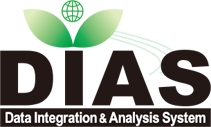


  |  |
| Name | DIAS Japanese 25-year ReAnalysis (JRA-25) |
| Metadata Identifier | JRA2520251203151817-DIAS20221121113753-en |
| Name | Numerical Prediction Division, Information Infrastructure Department |
|---|---|
| Organization | Japan Meteorological Agency |
| Address | 3-6-9 Toranomon, Minato City, Tokyo, 105-8431, Japan |
| jra@met.kishou.go.jp |
| Name | DIAS Office |
|---|---|
| Organization | Japan Agency for Marine-Earth Science and Technology |
| Address | 3173-25, Showa-Cho, Kanazawa-ku, Yokohama-shi, Kanagawa, 236-0001, Japan |
| dias-office@diasjp.net |
| Name | Numerical Prediction Division, Information Infrastructure Department |
|---|---|
| Organization | Japan Meteorological Agency |
| jra@met.kishou.go.jp |
| Name | The Japan Meteorological Agency (JMA) and the Central Research Institute of Electric Power Industry (CRIEPI) |
|---|---|
| jra@met.kishou.go.jp |
creation : 2010-06-22
The Japan Meteorological Agency (JMA) and the Central Research Institute of Electric Power Industry (CRIEPI) jointly conducted the Japanese 25-year Reanalysis (JRA-25) project for five years from 2001. Quality-controlled observational data from past decades and the latest numerical assimilation and prediction technology were used to produce a long-term record of the state of the atmosphere. The reanalysis covers the 26-year period from 1979 to 2004, and provides consistent and high-quality data. The JRA-25 product is widely used for research on meteorology and climatology, as well as for operational climate monitoring and seasonal forecasting.
Period reanalyzed: from Jan. 1979 to Dec. 2004 (26 years)
Global model resolution : T106L40 (model top: 0.4hPa)
Data assimilation : 3D-Var
Numerical assimilation system : JMA's operational system of April 2004.
In addition, SSM/I PW, and TOVS radiance level 1c (SSU) and 1d (HIRS, MSU) were assimilated.
climatologyMeteorologyAtmosphere
| Begin Date | 1979-01-01 |
| End Date | 2004-12-31 |
| North bound latitude | 90 |
| West bound longitude | -180 |
| Eastbound longitude | 180 |
| South bound latitude | -90 |
| Keyword Type | Keyword | Keyword thesaurus Name |
|---|---|---|
| theme | Climate | No_Dictionary |
| Keyword Type | Keyword | Keyword thesaurus Name |
|---|---|---|
| theme | DIAS > Data Integration and Analysis System | No_Dictionary |
JRA-25 Top Page : https://www.data.jma.go.jp/jra/html/JRA-25/index_en.html
JRA-25 Top Page (in Japanese) : https://www.data.jma.go.jp/jra/html/JRA-25/index_jp.html
file download : https://data.diasjp.net/dl/storages/filelist/dataset:140
Quality issues (in English) : https://www.data.jma.go.jp/jra/html/JRA-25/history/information_en.html
Quality issues (in Japanese) : https://www.data.jma.go.jp/jra/html/JRA-25/history/information.html
| name | version | specification |
|---|---|---|
| grib | no information |
(1)Users should provide user information including name, affiliation, e-mail address and purpose of data use.
(2)Users should not distribute the Products to any third party without JMA's prior
consent. Use of the Products for any commercial purposes is also prohibited.
(3)The source of the Products should be duly acknowledged in scientific or technical papers, publications, press releases or other communications regarding the Products.
Example:
The datasets used for this study are from the JRA-25 long-term reanalysis cooperative research project carried out by the Japan Meteorological Agency (JMA) and the Central Research Institute of Electric Power Industry (CRIEPI).
If data provider does not have data policy, DIAS Terms of Service (https://diasjp.net/en/terms/) and DIAS Privacy Policy (https://diasjp.net/en/privacy/) apply.
If there is a conflict between DIAS Terms of Service and data provider's policy, the data provider's policy shall prevail.
If you plan to use this dataset for a conference presentation, paper, journal article, or report etc., please include acknowledgments referred to following examples. If the data provider describes examples of acknowledgments, include them as well.
" In this study, [Name of Dataset] provided by [Name of Data Provider] was utilized. This dataset was also collected and provided under the Data Integration and Analysis System (DIAS), which was developed and operated by a project supported by the Ministry of Education, Culture, Sports, Science and Technology. "
Onogi, K., J. Tsutsui, H. Koide, M. Sakamoto, S. Kobayashi, H. Hatsushika, T. Matsumoto, N. Yamazaki, H. Kamahori, K. Takahashi, S. Kadokura, K. Wada, K. Kato, R. Oyama, T. Ose, N. Mannoji and R. Taira (2007) : The JRA-25 Reanalysis. J. Meteor. Soc. Japan, 85, 369-432.
Onogi, K., H. Koide, M. Sakamoto, S. Kobayashi, J. Tsutsui, H. Hatsushika, T. Matsumoto, N. Yamazaki, H. Kamahori, K. Takahashi, K. Kato, T. Ose, S. Kadokura and K. Wada 2005: JRA-25; Japanese 25-year Reanalysis --- progress and status ---. Quart. J. R. Meteorol. Soc., 131, 3259-3268.
Hatsushika, H., J.Tsutsui, M.Fiorino, K.Onogi (2006) : Impact of wind profile retrievals on the analysis of tropical cyclones in the JRA-25 reanalysis. J. Meteor. Soc. Japan, 84, 891-905.
Takahashi, K., N.Yamazaki, H.Kamahori (2006) : Trends of Heavy Precipitation Events in Global Observation and Reanalysis Datasets. SOLA, 2, 96-99, doi:10.2151/sola.2006-025.
Watarai, Y., H. L. Tanaka (2007) : Characteristics of the JRA-25 Dataset from the Viewpoint of Global Energetics. SOLA, 3, 9-12, doi:10.2151/sola.2007-003.
Ito, A. 2006. Simulation of global terrestrial carbon cycle using the JRA-25 reanalysis as forcing data. SOLA 2:148-151.
Tosiyuki Nakaegwa: Reproducibility of the seasonal cycles of land-surface hydrological variables in Japanese 25-year Reanalysis, Hydrological Research Letters, Vol. 2, pp.56-60, (2008).